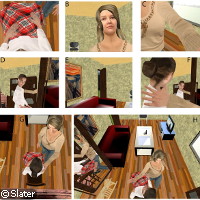Secrets of the opposite sex revealed, virtually
Technology created by European scientists has placed male volunteers into the virtual body of a woman. It is the only technology of its kind that convinces the user that the female body they are looking at is their own, providing an illusion not only of a different place but also of a different self. Presented in the journal Public Library of Science (PLoS) ONE, the research for the immersive virtual reality (IVR) initiative was part of the EU-funded PRESENCCIA and TRAVERSE projects, which received a total of EUR 8.81 million in support. PRESENCCIA ('Presence: research encompassing sensory enhancement, neuroscience, cerebral-computer interfaces and applications') received EUR 6.4 million under the 'Information society technologies' (IST) Thematic area of the Sixth Framework Programme (FP6). Its main objective was to better understand and use brain mechanisms to improve the virtual reality experience. TRAVERSE ('Transcending reality activating virtual environment responses through sensory enrichment') is a project led by Professor Melvyn Slater of the University of Barcelona in Spain. The Advance Grant of EUR 2.41 million was provided by the European Research Council (ERC) under the Seventh Framework Programme (FP7). These ERC grants are provided to established researchers for pioneering ideas that combine high risk with high-impact potential. In the current study, Professor Slater and his team conducted an experiment in which 24 male volunteers (none of whom had ever experienced virtual reality games before) wore headsets and were immersed in a virtual environment where they had to react to specific events. Some users were placed in a position to experience the environment through the eyes of a life-sized, virtual human female body (body substitute illusion); when they looked down at themselves, they could see their new body and clothes. Other volunteers were placed in a perspective slightly to the side of the woman. Unsurprisingly, the 'body swapping' effect was more pronounced with the former. In some cases, the experience was so effective that the volunteers gasped and flinched when they appeared to be threatened; the researchers reported a drop in heart rate, a typical reaction to a perceived attack. In the paper, the scientists explain that the experiment demonstrated that perceptual mechanisms can temporarily override knowledge, resulting in a radical illusion of body ownership transfer. The perception of movement and touch itself was sufficient enough to generate a body transfer illusion, a finding which is in contrast to earlier studies that 'assume visuotactile synchrony to be the critical contributory factor in ownership illusions'. They write: 'The research also illustrates immersive virtual reality as a powerful tool in the study of body representation and experience, since it supports experimental manipulations that would otherwise be infeasible, with the technology being mature enough to represent human bodies and their motion.' The evidence suggests that if you make people believe their bodies are different, it has an impact on the way they think and behave. This means, for instance, that with the technology we can experience what it is like to be a member of the opposite sex or someone with acute physical differences, such as an obese person. The experiment could lead to new ways of combating preconceptions and prejudices or help rehabilitate patients that have experienced strokes and other medical problems.



